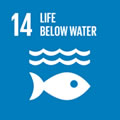Por favor, use este identificador para citar o enlazar a este item:
http://hdl.handle.net/10261/331202COMPARTIR / EXPORTAR:
 SHARE SHARE
 CORE
BASE CORE
BASE
|
|
| Visualizar otros formatos: MARC | Dublin Core | RDF | ORE | MODS | METS | DIDL | DATACITE | |

| Título: | Vertical and temporal distribution of chytrids infecting diatoms in the Gulf of Naples (Italy, Mediterranean Sea) |
Autor: | Reñé, Albert CSIC ORCID ; Timoneda Solé, Natàlia CSIC ORCID CVN ; Sarno, Diana; Piredda, Roberta; Zampicinini, Gianpaolo; Zingone, Adriana; Montresor, Marina; Garcés, Esther CSIC ORCID CVN | Palabras clave: | Diatoms LTER Marine chytrids Metabarcoding Protist interactions Zoosporic parasites |
Fecha de publicación: | jun-2023 | Editor: | John Wiley & Sons | Citación: | Marine Ecology 44(3): e12726 (2023) | Resumen: | The presence of phytoplankton parasites along the water column was explored at the Long-Term Ecological Station MareChiara (LTER-MC) in the Gulf of Naples (Mediterranean Sea) in October 2019. Microscopy analyses showed diatoms dominating the phytoplankton community in the upper layers (0–20 m). Metabarcoding data from the water column showed the presence of Chytridiomycota predominantly in the upper layers coinciding with the vertical distribution of diatoms. Laboratory incubations of natural samples enriched with different diatom cultures confirmed parasitic interactions of some of those chytrids—including members of Kappamyces—with diatom taxa. The temporal dynamics of diatoms and chytrids was also explored in a 3-year metabarcoding time-series (2011–2013) from surface waters of the study area and in sediment samples. Chytrids were recurrently present at low relative abundances, and some taxa found to infect diatoms in the incubation experiments were also identified in the ASV time-series. However, co-occurrence analyses did not show any clear or recurrent pairing patterns for chytrid and diatom taxa along the 3 years. The chytrid community in the sediments showed a clearly different species composition compared with that recorded in the water column samples, with higher diversity and relative abundance. The combination of observations, incubations, and metabarcoding confirmed that parasites are a common component of marine protist communities at LTER-MC. Host–parasite interactions must be determined and quantified to understand their role and the impact they have on phytoplankton dynamics | Descripción: | 16 pages, 7 figures, 1 table, supporting information https://doi.org/10.1111/maec.12726.-- Data Availability Statement: Data generated in this study including environmental parameters, phytoplankton counts, metabarcoding final datasets and results, images and videos generated from incubation experiments are deposited in the public repository DIGITAL.CSIC, accessible by the DOI 10.20350/digitalCSIC/14744 | Versión del editor: | https://doi.org/10.1111/maec.12726 | URI: | http://hdl.handle.net/10261/331202 | DOI: | 10.1111/maec.12726 | ISSN: | 0173-9565 | E-ISSN: | 1439-0485 |
| Aparece en las colecciones: | (ICM) Artículos |
Ficheros en este ítem:
| Fichero | Descripción | Tamaño | Formato | |
|---|---|---|---|---|
| Reñe_et_al_2023.pdf | 5,19 MB | Adobe PDF |  Visualizar/Abrir | |
| Reñe_et_al_2023_suppl.docx | 731,5 kB | Microsoft Word XML | Visualizar/Abrir |
CORE Recommender
SCOPUSTM
Citations
4
checked on 09-abr-2024
WEB OF SCIENCETM
Citations
3
checked on 27-feb-2024
Page view(s)
47
checked on 26-abr-2024
Download(s)
39
checked on 26-abr-2024
Google ScholarTM
Check
Altmetric
Altmetric
Este item está licenciado bajo una Licencia Creative Commons



